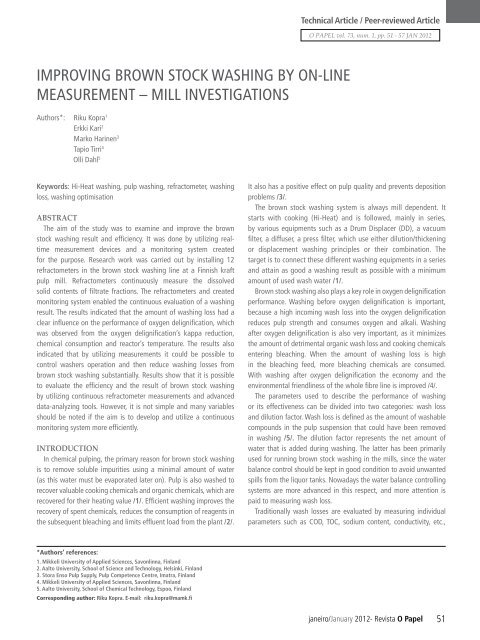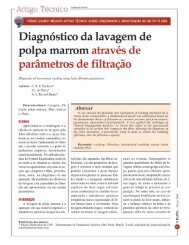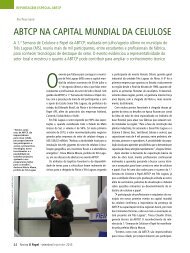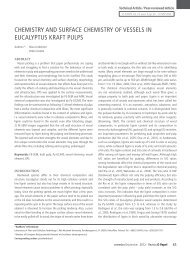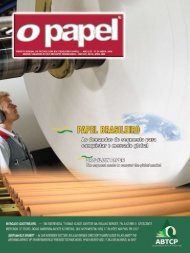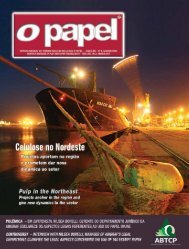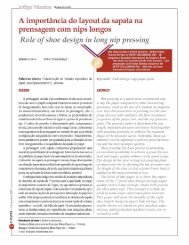pós-graduação - Revista O Papel
pós-graduação - Revista O Papel
pós-graduação - Revista O Papel
You also want an ePaper? Increase the reach of your titles
YUMPU automatically turns print PDFs into web optimized ePapers that Google loves.
Technical Article / Peer-reviewed Article<br />
O PAPEL vol. 73, num. 1, pp. 51 - 57 JAN 2012<br />
Improving brown stock washing by on-line<br />
measurement – Mill investigations<br />
Authors*: Riku Kopra 1<br />
Erkki Kari 2<br />
Marko Harinen 3<br />
Tapio Tirri 4<br />
Olli Dahl 5<br />
Keywords: Hi-Heat washing, pulp washing, refractometer, washing<br />
loss, washing optimisation<br />
ABSTRACT<br />
The aim of the study was to examine and improve the brown<br />
stock washing result and efficiency. It was done by utilizing realtime<br />
measurement devices and a monitoring system created<br />
for the purpose. Research work was carried out by installing 12<br />
refractometers in the brown stock washing line at a Finnish kraft<br />
pulp mill. Refractometers continuously measure the dissolved<br />
solid contents of filtrate fractions. The refractometers and created<br />
monitoring system enabled the continuous evaluation of a washing<br />
result. The results indicated that the amount of washing loss had a<br />
clear influence on the performance of oxygen delignification, which<br />
was observed from the oxygen delignification’s kappa reduction,<br />
chemical consumption and reactor’s temperature. The results also<br />
indicated that by utilizing measurements it could be possible to<br />
control washers operation and then reduce washing losses from<br />
brown stock washing substantially. Results show that it is possible<br />
to evaluate the efficiency and the result of brown stock washing<br />
by utilizing continuous refractometer measurements and advanced<br />
data-analyzing tools. However, it is not simple and many variables<br />
should be noted if the aim is to develop and utilize a continuous<br />
monitoring system more efficiently.<br />
INTRODUCTION<br />
In chemical pulping, the primary reason for brown stock washing<br />
is to remove soluble impurities using a minimal amount of water<br />
(as this water must be evaporated later on). Pulp is also washed to<br />
recover valuable cooking chemicals and organic chemicals, which are<br />
recovered for their heating value /1/. Efficient washing improves the<br />
recovery of spent chemicals, reduces the consumption of reagents in<br />
the subsequent bleaching and limits effluent load from the plant /2/.<br />
It also has a positive effect on pulp quality and prevents deposition<br />
problems /3/.<br />
The brown stock washing system is always mill dependent. It<br />
starts with cooking (Hi-Heat) and is followed, mainly in series,<br />
by various equipments such as a Drum Displacer (DD), a vacuum<br />
filter, a diffuser, a press filter, which use either dilution/thickening<br />
or displacement washing principles or their combination. The<br />
target is to connect these different washing equipments in a series<br />
and attain as good a washing result as possible with a minimum<br />
amount of used wash water /1/.<br />
Brown stock washing also plays a key role in oxygen delignification<br />
performance. Washing before oxygen delignification is important,<br />
because a high incoming wash loss into the oxygen delignification<br />
reduces pulp strength and consumes oxygen and alkali. Washing<br />
after oxygen delignification is also very important, as it minimizes<br />
the amount of detrimental organic wash loss and cooking chemicals<br />
entering bleaching. When the amount of washing loss is high<br />
in the bleaching feed, more bleaching chemicals are consumed.<br />
With washing after oxygen delignification the economy and the<br />
environmental friendliness of the whole fibre line is improved /4/.<br />
The parameters used to describe the performance of washing<br />
or its effectiveness can be divided into two categories: wash loss<br />
and dilution factor. Wash loss is defined as the amount of washable<br />
compounds in the pulp suspension that could have been removed<br />
in washing /5/. The dilution factor represents the net amount of<br />
water that is added during washing. The latter has been primarily<br />
used for running brown stock washing in the mills, since the water<br />
balance control should be kept in good condition to avoid unwanted<br />
spills from the liquor tanks. Nowadays the water balance controlling<br />
systems are more advanced in this respect, and more attention is<br />
paid to measuring wash loss.<br />
Traditionally wash losses are evaluated by measuring individual<br />
parameters such as COD, TOC, sodium content, conductivity, etc.,<br />
*Authors’ references:<br />
1. Mikkeli University of Applied Sciences, Savonlinna, Finland<br />
2. Aalto University, School of Science and Technology, Helsinki, Finland<br />
3. Stora Enso Pulp Supply, Pulp Competence Centre, Imatra, Finland<br />
4. Mikkeli University of Applied Sciences, Savonlinna, Finland<br />
5. Aalto University, School of Chemical Technology, Espoo, Finland<br />
Corresponding author: Riku Kopra. E-mail: riku.kopra@mamk.fi<br />
janeiro/January 2012- <strong>Revista</strong> O <strong>Papel</strong><br />
51


